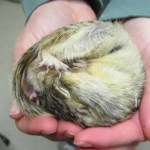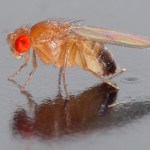
By Hector Bottai (Own work) [CC BY-SA 3.0 (http://creativecommons.org/licenses/by-sa/3.0)], via Wikimedia Commons
I just read an interesting blog entry from I Spy Physiology describing how woodpeckers avoid getting concussions even though they routinely bang their heads. By routinely, I mean an impressive 12,000 times a day approximately. I was amazed to learn that each time a woodpecker taps a tree, the impact is about 10 times that of an average hit in football. Turns out woodpeckers have an anatomical advantage. To find out what that advantage is, visit the blog!
Left Top: Pacific hatchetfish; Left Bottom: longfin lanternfish; Right: an acoustic instrument in the Pacific Ocean. (Images from Scripps Institution of Oceanography press release)
I love a good mystery. This one has puzzled scientists for several years now...ever since they discovered a humming or buzzing noise in the Pacific ocean, an otherwise rather quiet place. This was no ordinary noise, that they knew of. In a recent interview on NPR, Dr. Simone Baumann-Pickering, Scripps Institution of Oceanography (La Jolla, California) shared what she and her team think is causing all that noise…
I am excited to report that it's that time of year again when the American Physiological Society hosts their annual video contest! This year's Phantastic Physiology Voyage theme is “Function Follows Form.”
Here is just a sample of the fun videos in the contest:
Please vote for your favorite physiology video here!
The Puerto Rico Physiological Society held their 6th annual meeting at the University of Puerto Rico this past Friday February 12th. The theme of the meeting was "Pathophysiological Mechanisms of Stress: From Cells to Organisms." While the meeting did not feature much of what would be considered comparative physiology, there were several really good talks on how different forms of stress impact physiology.
This year's American Physiological Society lecture was given by Dr. Ajit Varki who spoke about the role of so-called "siglecs" in both aging and inflammation. According to his biography on…
Image of Steller sea lion by Daniel Hershman from Federal Way, US (A crashing wave) [CC BY 2.0 (http://creativecommons.org/licenses/by/2.0)], via Wikimedia Commons
Animals exposed to military sonar are thought to develop symptoms similar to decompression sickness. Since microparticles in the blood are known to increase with decompression sickness in diving land animals, researchers explored whether levels were also increased in Steller sea lions (Eumetopias jubatus), that similarly hold their breath while diving. Microparticles are fragments of cell membranes. The research team…
New research published in Biology Letters suggests that, similar to dogs, horses may understand our facial expressions. In a quote published in Discovery News, study author Amy Smith (University of Sussex) said, "It's possible that horses developed this ability during their 6,000-year co-evolution with humans, or indeed that individual horses learn it during their lifetimes."
To examine this question, the research team showed images of men with negative or positive facial expressions to 28 horses:
Sources:
AV Smith, L Proops, K Grounds, J Wathan, K McComb. Functionally relevant responses to…
By Hollingsworth John and Karen, U.S. Fish and Wildlife Service [Public domain], via Wikimedia Commons
Researchers are spending a lot of time exploring how the microbes living in our guts impact our health. In a new study published in Cell Reports, researchers wanted to know how the gut microbes of wild brown bears changes between summer and hibernation. They discovered that during the summer, the microbial species present in the gut are more diverse and are of the type that helps store energy. In fact, when the research team gave the microbes to rodents, the rodents gained…
Image of a hibernating thirteen-lined ground squirrel from University of Minnesota Duluth researcher Matthew Andrews.
Thirteen-lined ground squirrels (Ictidomys tridecemlineatus) are really cute when they hibernate (above). During torpor bouts, their body temperature decreases to a few degrees Celsius and their metabolism drops by as much as 95% with heart rates ranging from only 3-10 beats per minute. These bouts of torpor are interrupted by periodic arousals every couple of weeks during which their metabolism increases as body temperature elevates to 37 degrees…
As I was perusing YouTube I came across a video from National Geographic that I must admit was fascinating while at the same time disturbing. The video describes how rats are able to travel from the sewer into your toilet.
Although this is reportedly an uncommon occurence, I will be sure to look before I sit from now on.
New research shows that premotor neurons are activated in the brains of adolescent male zebra finches whenever a young bird hears their father (a tutor) sing. These are the same neurons that are usually activated in anticipation of movement. What is special about this, is that as the birds learned new songs or pieces of new songs, activation of these neurons declined. This effect was due to inhibitory interneurons whose firing frequency increased as the birds practiced and improved their accuracy. Activation of these inhibitory interneurons prevented any further changes to…
As 2015 comes to an end, I always love to review the top newly named species of the year. Here are the top 10 (in alphabetical order) as determined by an international taxonomist committee:
LOVE the cartwheeling spider!!
Source:
State University of New York, College of Environmental Science and Forestry (ESF).
"Drosophila melanogaster - side (aka)" by André Karwath aka Aka - Own work. Licensed under CC BY-SA 2.5 via Wikimedia Commons -
Researchers at the University of California at San Diego were interested in understanding how exposure to low oxygen concentrations impact heart function. For humans low oxygen delivery to the heart can occur with exposure to high altitude, respiratory diseases, inflammation, blood clots and during a heart attack when there is inadequate blood flow to the heart muscle. The results of their study were recently published in the American Journal…
According to the Linus Pauling Institute at Oregon State University, folate (which includes folates from food and folic acid supplements) is important for amino acid metabolism and methylation reactions in the body. Anyone who has had a baby knows that folic acid is an important nutrient to prevent the birth defect spina bifida. Folate and vitamin B-12 deficiency may also lead to a type of anemia known as megaloblastic anemia.
Image from CDC
New research published in Physiological Reports examined baboons to find out how maternal obesity and excess nutrient…
If you own a dog you may agree that it seems as if they understand our feelings. While some may call this anthropomorphizing, you know ascribing human emotions to animals, new research may vindicate the feelings of many pet owners. A study recently published in Royal Society Open Science provides evidence to suggest that dogs can mimic the emotional state of their owners as well as their canine friends, a process similar to empathy called emotional cognition. The research team recorded the behavior of animals at a dog park in Palermo, Italy and noticed that the…
I read an interesting article in the Alaska Dispatch News which examined interactions between arctic grizzly bears and polar bears. They found that although polar bears are larger, they tend to leave food sources when grizzly bears are around. This may be because polar bears typically spend a lot of time on sea ice without the need to be aggressive towards competitors. Of concern is that the relatively passive nature of polar bears may be detrimental considering these animals are increasingly spending more time foraging on land during the summer and fall months.…
Researchers from the University of York and the University of St. Andrews in the United Kingdom observed greater vasa parrots (Coracopsis vasa) using pebbles and date pits to extract a fine calcium powder from seashells that they would then lick off the shell. Their observations were published in Biology Letters. The birds were in essence creating their own nutritional supplements from materials readily available in their cages. While parrots are known to use their beaks to extract calcium from shells, this study shows the first known example of them using tools to accomplish…
Zinc deficiency is sometimes diagnosed in infants who are exclusively breast-fed. It can occur because of a dysfunctional zinc transporter in the mother, which prevents zinc from being secreted into the breast milk through a special zinc transporter in the epithelial cells of the mammary gland (Chowanadisai et al., 2006). It could also be inherited.
Zinc is important for the production of lactose (milk sugar). In addition, infants with zinc deficiency may develop dermatitis on their face (image below), diarrhea, as well as neurological changes which may alter their behavior (Medscape).
A new…
You are probably thinking, whose bird-brained idea was that?
Well, as it turns out, a new study published in PLOS ONE shows that pigeons can be trained to accurately differentiate cancerous versus healthy tissue biopsies. This is because the process of diagnosing cancer involves visual screening of MRIs an biopsies and pigeons use similar visual processing as humans. Moreover, according to the article, pigeons are able to learn and memorize over 2000 images, a skill that likely helps in identifying cancerous cells.
In a quote from Scientific American, study author Dr. Richard Levenson (…
Photo of cat eating meat from Wikimedia Commons. Photo by Tom Corser www.tomcorser.com. Licensed under Creative Commons Attribution ShareAlike 2.0 England & Wales (UK) Licence: http://creativecommons.org/licenses/by-sa/2.0/uk/deed.en_GB
A new study published in PLOS ONE that examined bitter taste receptors in cats may provide evidence as to why felines are such finicky eaters.
Unlike my cat that seems to take after Garfield in his dietary choices, most cats are purely carnivorous. Cats are reportedly unable to taste sweets thus plant-based starches are not typically desirable. This is…
Image of chicken egg from Wikimedia Commons.
Turns out the egg is an important phase. A new study published this month in American Journal of Physiology - Regulatory, Integrative and Comparative Physiology looked at what happens in the egg when a chicken fetus was exposed to low oxygen (hypoxia) conditions. In mammals, this can occur as a result of maternal hypoxia, preeclampsia as well as anemia in the fetus resulting in less red blood cells that can carry oxygen. Understanding this is important as restricted fetal growth is associated with an increased risk…



